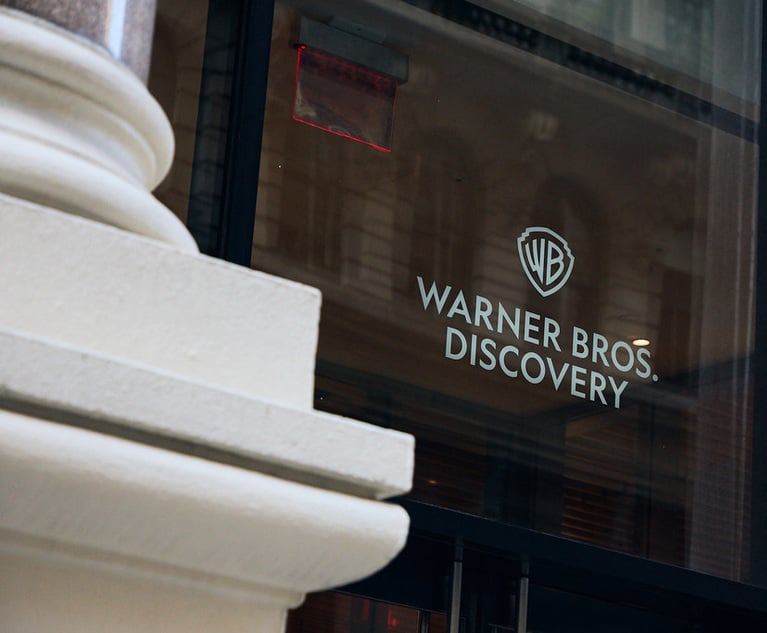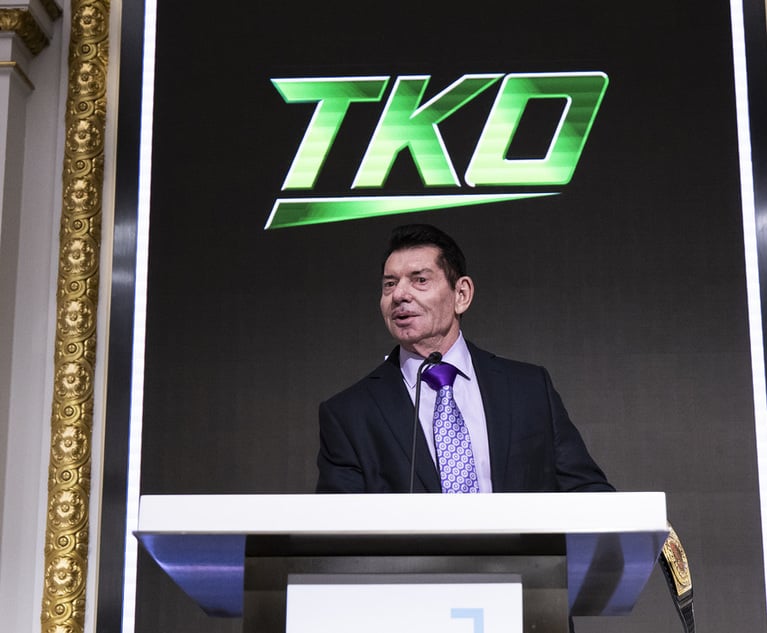IP: Defending Against Counterfeiting
Being aware of civil counterfeiting cause of action and related strategies is vital to defending the integrity of a brand.
May 02, 2011 at 08:00 PM
10 minute read
The original version of this story was published on Law.com
 Trademark counterfeiting can damage a company's market and brand in short order. Considering the ease with which counterfeiters can market their illegitimate goods, particularly over the internet, any consumer product company that invests significant resources to develop a fashionable and trusted image should be well aware of the civil counterfeiting cause of action and related strategies.
Trademark counterfeiting can damage a company's market and brand in short order. Considering the ease with which counterfeiters can market their illegitimate goods, particularly over the internet, any consumer product company that invests significant resources to develop a fashionable and trusted image should be well aware of the civil counterfeiting cause of action and related strategies.
Because remedies for trademark counterfeiting are severe, including, for example, treble damages and ex parte seizure of counterfeit goods, strict standards must be met to bring a civil trademark counterfeiting claim. The complainant must own a federal registration on the United States Patent and Trademark Office's Principal Trademark Register for a trademark that is “identical with or substantially indistinguishable from” the allegedly counterfeit mark. Additionally, the complainant's federal trademark registration must recite the exact class of goods or services to which the alleged counterfeit mark is attached. This is not to say, however, that the accused goods need be strictly identical to the complainant's goods to be considered counterfeits. For example, if the genuine goods are suitcases made of leather, then a copy bearing the suitcase maker's registered trademark, but made of another material instead of leather, could still be considered counterfeit. To support a counterfeiting claim, the complainant's registered mark must also be currently in use in connection with the goods and services recited in the trademark registration. For these reasons, it is critical that a company considering enforcement action carefully audit its trademark portfolio to confirm the relevant marks are validly registered and that the marks are currently in use on the relevant goods.
Importantly, the allegedly counterfeit mark must be an unauthorized use of the complainant's validly registered trademark. In other words, if the producer of the accused goods was authorized by the trademark owner to produce the products bearing the mark, then the resulting products cannot be counterfeits. While this may sound obvious, as a practical matter it effectively eliminates two problematic abuses of a company's trademarks from the scope of the counterfeiting laws.
First, a contract manufacturer's unauthorized sale of “overruns” is not actionable under the counterfeiting laws. Overruns are excess products produced by the trademark owner's contract manufacturer or other licensee that the trademark owner is unable to sell. If the manufacturer has a current license with the trademark owner at the time the overruns are produced, then the overruns are considered authorized as a matter of law and they will not be considered counterfeit. Accordingly, a trademark owner must protect itself against its manufacturer's sales of overruns by working with trusted manufacturers and by carefully defining the relationship and the trademark rights through contractual means. It should be noted that the overrun exception to the counterfeiting laws is inapplicable if the goods produced by the trademark owner's licensee are defective or otherwise irregular. In such cases, the manufacturer's use of the mark would result in consumer deception by allowing the manufacturer to foist goods upon the public that do not meet the trademark owner's quality requirements.
Second, gray market goods, also known as parallel imports, are beyond the reach of the counterfeiting laws because they are authorized uses of the trademark owner's brand. Gray market goods are those that bear the trademark owner's genuine mark and that find their way into the United States even though they were intended for sale outside of the United States. This presents problems for a trademark owner because the branded products may be tailored to the tastes of a remote foreign market and may differ materially from the trademark owner's version of the same product intended for the United States market. For example, the scent and lather of a bath soap sold under the Scottish Creek trademark may differ significantly for the Japanese market as opposed to the U.S. market. However, if gray goods are relabeled or repackaged without authorization in a way that will confuse consumers, then they may be considered counterfeit.
Where counterfeiting occurs the available civil remedies are powerful. The brand owner may seek an injunction but, unlike a trademark infringement case, may also request ex parte seizure of the counterfeit products along with the “means of making” the counterfeit marks. The option of ex parte seizure is made available to prevent counterfeiters from merely moving the counterfeit goods to another counterfeiter or from destroying evidence of their culpability after receiving notice of suit. The damages available to remedy counterfeiting are enhanced, including what amounts to mandatory attorney fees and treble damages or profits, with the option for statutory damages as an alternative. Moreover, a civil counterfeiting suit does not preclude the United States government from bringing criminal counterfeiting charges in appropriate circumstances. Notably, Customs and Border Protection can also be of great assistance in preventing entry of counterfeit goods. Brand owners at risk of counterfeiting may record their key trademarks with Customs and Border Protection, along with product identification information and training materials to assist Customs officials in differentiating authentic products from counterfeits at the point of entry.
Proactive trademark registrations, an understanding of the limitations of the counterfeiting laws, coordination with federal officials, as well as technological solutions applied to authentic packaging and products, such as holograms, invisible inks and the like, can help companies with hot and fashionable brands deal effectively with an onslaught of predatory counterfeiters.
Read Christopher Dolan's previous column.
 Trademark counterfeiting can damage a company's market and brand in short order. Considering the ease with which counterfeiters can market their illegitimate goods, particularly over the internet, any consumer product company that invests significant resources to develop a fashionable and trusted image should be well aware of the civil counterfeiting cause of action and related strategies.
Trademark counterfeiting can damage a company's market and brand in short order. Considering the ease with which counterfeiters can market their illegitimate goods, particularly over the internet, any consumer product company that invests significant resources to develop a fashionable and trusted image should be well aware of the civil counterfeiting cause of action and related strategies.
Because remedies for trademark counterfeiting are severe, including, for example, treble damages and ex parte seizure of counterfeit goods, strict standards must be met to bring a civil trademark counterfeiting claim. The complainant must own a federal registration on the United States Patent and Trademark Office's Principal Trademark Register for a trademark that is “identical with or substantially indistinguishable from” the allegedly counterfeit mark. Additionally, the complainant's federal trademark registration must recite the exact class of goods or services to which the alleged counterfeit mark is attached. This is not to say, however, that the accused goods need be strictly identical to the complainant's goods to be considered counterfeits. For example, if the genuine goods are suitcases made of leather, then a copy bearing the suitcase maker's registered trademark, but made of another material instead of leather, could still be considered counterfeit. To support a counterfeiting claim, the complainant's registered mark must also be currently in use in connection with the goods and services recited in the trademark registration. For these reasons, it is critical that a company considering enforcement action carefully audit its trademark portfolio to confirm the relevant marks are validly registered and that the marks are currently in use on the relevant goods.
Importantly, the allegedly counterfeit mark must be an unauthorized use of the complainant's validly registered trademark. In other words, if the producer of the accused goods was authorized by the trademark owner to produce the products bearing the mark, then the resulting products cannot be counterfeits. While this may sound obvious, as a practical matter it effectively eliminates two problematic abuses of a company's trademarks from the scope of the counterfeiting laws.
First, a contract manufacturer's unauthorized sale of “overruns” is not actionable under the counterfeiting laws. Overruns are excess products produced by the trademark owner's contract manufacturer or other licensee that the trademark owner is unable to sell. If the manufacturer has a current license with the trademark owner at the time the overruns are produced, then the overruns are considered authorized as a matter of law and they will not be considered counterfeit. Accordingly, a trademark owner must protect itself against its manufacturer's sales of overruns by working with trusted manufacturers and by carefully defining the relationship and the trademark rights through contractual means. It should be noted that the overrun exception to the counterfeiting laws is inapplicable if the goods produced by the trademark owner's licensee are defective or otherwise irregular. In such cases, the manufacturer's use of the mark would result in consumer deception by allowing the manufacturer to foist goods upon the public that do not meet the trademark owner's quality requirements.
Second, gray market goods, also known as parallel imports, are beyond the reach of the counterfeiting laws because they are authorized uses of the trademark owner's brand. Gray market goods are those that bear the trademark owner's genuine mark and that find their way into the United States even though they were intended for sale outside of the United States. This presents problems for a trademark owner because the branded products may be tailored to the tastes of a remote foreign market and may differ materially from the trademark owner's version of the same product intended for the United States market. For example, the scent and lather of a bath soap sold under the Scottish Creek trademark may differ significantly for the Japanese market as opposed to the U.S. market. However, if gray goods are relabeled or repackaged without authorization in a way that will confuse consumers, then they may be considered counterfeit.
Where counterfeiting occurs the available civil remedies are powerful. The brand owner may seek an injunction but, unlike a trademark infringement case, may also request ex parte seizure of the counterfeit products along with the “means of making” the counterfeit marks. The option of ex parte seizure is made available to prevent counterfeiters from merely moving the counterfeit goods to another counterfeiter or from destroying evidence of their culpability after receiving notice of suit. The damages available to remedy counterfeiting are enhanced, including what amounts to mandatory attorney fees and treble damages or profits, with the option for statutory damages as an alternative. Moreover, a civil counterfeiting suit does not preclude the United States government from bringing criminal counterfeiting charges in appropriate circumstances. Notably, Customs and Border Protection can also be of great assistance in preventing entry of counterfeit goods. Brand owners at risk of counterfeiting may record their key trademarks with Customs and Border Protection, along with product identification information and training materials to assist Customs officials in differentiating authentic products from counterfeits at the point of entry.
Proactive trademark registrations, an understanding of the limitations of the counterfeiting laws, coordination with federal officials, as well as technological solutions applied to authentic packaging and products, such as holograms, invisible inks and the like, can help companies with hot and fashionable brands deal effectively with an onslaught of predatory counterfeiters.
Read Christopher Dolan's previous column.
This content has been archived. It is available through our partners, LexisNexis® and Bloomberg Law.
To view this content, please continue to their sites.
Not a Lexis Subscriber?
Subscribe Now
Not a Bloomberg Law Subscriber?
Subscribe Now
NOT FOR REPRINT
© 2025 ALM Global, LLC, All Rights Reserved. Request academic re-use from www.copyright.com. All other uses, submit a request to [email protected]. For more information visit Asset & Logo Licensing.
You Might Like
View All


SEC Puts Beat Down on Ex-Wrestling CEO Vince McMahon for Not Reporting Settlements
3 minute readTrending Stories
- 1'It's Not Going to Be Pretty': PayPal, Capital One Face Novel Class Actions Over 'Poaching' Commissions Owed Influencers
- 211th Circuit Rejects Trump's Emergency Request as DOJ Prepares to Release Special Counsel's Final Report
- 3Supreme Court Takes Up Challenge to ACA Task Force
- 4'Tragedy of Unspeakable Proportions:' Could Edison, DWP, Face Lawsuits Over LA Wildfires?
- 5Meta Pulls Plug on DEI Programs
Who Got The Work
Michael G. Bongiorno, Andrew Scott Dulberg and Elizabeth E. Driscoll from Wilmer Cutler Pickering Hale and Dorr have stepped in to represent Symbotic Inc., an A.I.-enabled technology platform that focuses on increasing supply chain efficiency, and other defendants in a pending shareholder derivative lawsuit. The case, filed Oct. 2 in Massachusetts District Court by the Brown Law Firm on behalf of Stephen Austen, accuses certain officers and directors of misleading investors in regard to Symbotic's potential for margin growth by failing to disclose that the company was not equipped to timely deploy its systems or manage expenses through project delays. The case, assigned to U.S. District Judge Nathaniel M. Gorton, is 1:24-cv-12522, Austen v. Cohen et al.
Who Got The Work
Edmund Polubinski and Marie Killmond of Davis Polk & Wardwell have entered appearances for data platform software development company MongoDB and other defendants in a pending shareholder derivative lawsuit. The action, filed Oct. 7 in New York Southern District Court by the Brown Law Firm, accuses the company's directors and/or officers of falsely expressing confidence in the company’s restructuring of its sales incentive plan and downplaying the severity of decreases in its upfront commitments. The case is 1:24-cv-07594, Roy v. Ittycheria et al.
Who Got The Work
Amy O. Bruchs and Kurt F. Ellison of Michael Best & Friedrich have entered appearances for Epic Systems Corp. in a pending employment discrimination lawsuit. The suit was filed Sept. 7 in Wisconsin Western District Court by Levine Eisberner LLC and Siri & Glimstad on behalf of a project manager who claims that he was wrongfully terminated after applying for a religious exemption to the defendant's COVID-19 vaccine mandate. The case, assigned to U.S. Magistrate Judge Anita Marie Boor, is 3:24-cv-00630, Secker, Nathan v. Epic Systems Corporation.
Who Got The Work
David X. Sullivan, Thomas J. Finn and Gregory A. Hall from McCarter & English have entered appearances for Sunrun Installation Services in a pending civil rights lawsuit. The complaint was filed Sept. 4 in Connecticut District Court by attorney Robert M. Berke on behalf of former employee George Edward Steins, who was arrested and charged with employing an unregistered home improvement salesperson. The complaint alleges that had Sunrun informed the Connecticut Department of Consumer Protection that the plaintiff's employment had ended in 2017 and that he no longer held Sunrun's home improvement contractor license, he would not have been hit with charges, which were dismissed in May 2024. The case, assigned to U.S. District Judge Jeffrey A. Meyer, is 3:24-cv-01423, Steins v. Sunrun, Inc. et al.
Who Got The Work
Greenberg Traurig shareholder Joshua L. Raskin has entered an appearance for boohoo.com UK Ltd. in a pending patent infringement lawsuit. The suit, filed Sept. 3 in Texas Eastern District Court by Rozier Hardt McDonough on behalf of Alto Dynamics, asserts five patents related to an online shopping platform. The case, assigned to U.S. District Judge Rodney Gilstrap, is 2:24-cv-00719, Alto Dynamics, LLC v. boohoo.com UK Limited.
Featured Firms
Law Offices of Gary Martin Hays & Associates, P.C.
(470) 294-1674
Law Offices of Mark E. Salomone
(857) 444-6468
Smith & Hassler
(713) 739-1250







